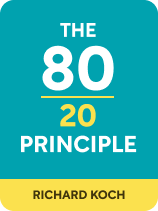

This article is an excerpt from the Shortform book guide to "The 80/20 Principle" by Richard Koch. Shortform has the world's best summaries and analyses of books you should be reading.
Like this article? Sign up for a free trial here .
What is Richard Koch’s The 80/20 Principle about? What is the key message to take away from the book?
In his book The 80/20 Principle, Richard Koch explains that the successful few are simply leveraging a fundamental truth at work in all of our lives: 80% of results stem from 20% of inputs. Therefore, Koch says you must spend more time on what matters, and less time on what doesn’t—for example, by finding work you enjoy, spending less time on things you’re not good at, and avoiding people who drain your energy.
Below is a brief overview of the key themes.
The Definition of the 80/20 Principle
In The 80/20 Principle, Richard Koch argues that the 80/20 Principle is at work in every aspect of our lives, and we can use this principle to simplify and optimize our lives.
The 80/20 Principle dictates that 80% of outputs stem from 20% of inputs. This unbalanced relationship, Koch says, shows up in various areas of life. For example, in any given company, we can reliably predict that 20% of products account for 80% of profits, 20% of customers account for 80% of sales revenue, and 20% of employees account for 80% of results. Similarly, in our personal lives, we owe roughly 80% of our achievements to 20% of the time we invest, 80% of our happiness to 20% of our life experiences, and 80% of the value we derive from relationships to 20% of the people in our lives.
(Shortform note: Koch credits discovery of the 80/20 relationship between inputs and outputs to Italian economist Vilfredo Pareto. According to Koch, Pareto studied wealth concentration among people in 19th-century England and discovered that a minority of people held the majority of wealth. Many people have commented on Pareto’s discovery using many different terms. For example, in Eat That Frog!, Brian Tracy refers to the “80/20 rule.” Similar to Koch, Tracy says we should complete the most important task (the biggest frog) first. Also, in The One Thing, Gary Keller refers to the “Pareto Principle” and gives similar advice: Focus on the few, highest-impact efforts to create extraordinary results.)
Why the 80/20 Principle Matters
Koch assures us that we can apply the 80/20 principle to clear out the waste in our lives and devote our energy to the people and activities that bring us joy and success.
According to Koch, most of us waste tremendous energy and effort in our work lives on things that don’t ultimately matter. We respond to every email request, accept every meeting invitation, and devote our precious time to people who don’t advance our career development. As a result, Koch says, trivial concerns dominate our days, which leads to widespread inefficiency, dissatisfaction, and missed opportunities. Instead, Koch says we should focus on the 20% of tasks responsible for 80% of our productivity.
We also waste energy and effort in our personal lives, according to Koch. We fill our days with errands and unfulfilling distractions like social media, and we spend too much time with people we don’t like or who drain our energy. As a result, Koch says, we have an underlying sense of unhappiness. Instead, Koch says we should focus on the 20% of life activities that are responsible for 80% of our happiness.
(Shortform note: Koch rightly points out that many people spend inordinate amounts of time on activities that arguably produce low returns. For example, data shows that people spend an average of 147 minutes per day on social media and about three hours per day watching TV. Also, employees spend 28% of work time on email. Reallocating these blocks of time, as Koch suggests, may indeed result in more happiness and productivity. However, there’s no guarantee. One study on social media usage revealed no significant change in a person’s mood after they quit social media for one to four weeks.)
However, Koch asserts that when people do focus their efforts on the things that matter, they prosper. People are happier and more productive doing things they actually enjoy. Companies are more streamlined and profitable and are able to deliver greater value to customers.
(Shortform note: Is Koch right to link happiness and productivity? Research says yes. According to an extensive study on happiness and productivity, workers are 13% more productive when happy. Happy workers don’t work more hours—they are simply more productive than their unhappy colleagues during their time at work.)
Evidence for the Validity of the 80/20 Principle
How do we know the 80/20 Principle is real? What factors explain it? Koch says the causes are difficult to isolate because there are many interdependencies. For example, two employees may have the exact same training but differ greatly in their contributions to a company. Is the performance gap due to different working conditions, levels of motivation, mental distress, support from colleagues, or something else entirely? Koch says it’s impossible to know, and ultimately it doesn’t matter.
We can verify the reality of the 80/20 Principle by observing its effects, and Koch encourages us to test his assertions against our experience. What we will find—reliably and consistently—is that some inputs have a huge influence whereas others are relatively insignificant. This unbalanced relationship will persist, Koch says, unless we make a determined effort to change it.
The Mindset Shifts to Make to Take Advantage of the 80/20 Principle
Now that you know what the 80/20 Principle is and why it matters, let’s examine the mindset shifts you must make to take advantage of the 80/20 Principle and achieve the happiness and success you want. Koch identifies three core beliefs you must embrace: Major improvements are always possible, it’s your duty to enjoy life, and time is abundant.
Core Belief #1: Major Improvements Are Always Possible
First, Koch says, we need to assume that the way we currently do things is compromising our happiness and success. We must abandon the notion that we’ve already done all we possibly can to improve our lives, as this mindset will prevent us from realizing our potential.
Instead, we must internalize the belief that we can greatly improve the quality of our lives by applying the 80/20 Principle. The reality, Koch says, is that we can always make major improvements to increase our wealth, happiness, freedom, and knowledge—either by doing things differently or doing less. Once we embrace this insight, we can take action to expand the 20% of our lives that help us make those improvements.
Core Belief #2: It’s Our Duty to Enjoy Life
Second, Koch says we need to stop feeling guilty for working less and doing things we enjoy. We must abandon the notion that seeking pleasure equates to selfishness, laziness, or apathy. This mindset leaves us unfulfilled, resentful, and tethered to tasks and people that undercut our joy.
(Shortform note: Research shows that our brains are hardwired to seek pleasure, so Koch’s advice to give up guilt around doing things we enjoy syncs up with our evolutionary design. Humans have an inherent drive to seek pleasure, which is what drove our ancestors to find food, shelter, and mating opportunities. So, enjoying ourselves is natural—and actually helps us stay healthy by reducing stress.)
Instead, we must embrace the belief that it’s our duty to seek pleasure and enjoy life. Why? According to Koch, we have a duty to achieve greatness, and we’re much more likely to achieve greatness when we enjoy pursuing it. However, Koch does not endorse a life of total relaxation and luxury. He says pleasure-seeking must go hand-in-hand with extreme ambition—“ambition” in the sense of wanting to contribute value and change things for the better.
Koch says we need to apply the 80/20 Principle to focus on the 20% of activities that bring us pleasure. Filling our lives with enjoyable activities will help us cultivate the mindset necessary to achieve greatness. We’ll be happier doing things we actually enjoy and thus become more productive, which will enable us to prosper.
(Shortform note: Research supports Koch’s assertion: A study on over one million people found that happier people earn more rewards, have better relationships with peers, and are more likely to become leaders. Furthermore, they tend to be healthier, more creative, and more motivated to succeed. These results held even after accounting for a range of variables, including status, gender, race, and education.)
Core Belief #3: Time Is Abundant
Third, Koch says that we need to give up the belief that there is a shortage of time. When we regard time as a scarce resource, the only option we can see for doing more of what we love is to squeeze pleasurable activities into the gaps of our lives. We feel compelled to do more because we think that doing more with a seemingly small amount of time is the only way to experience more of what we want. We can’t see any way to eliminate anything without compromising our livelihoods.
Instead, Koch says we need to embrace a completely new view of time. In reality, he says, time is abundant, and this perspective will revolutionize our lives: According to the 80/20 Principle, we’re most productive during a mere 20% of the time we spend working. If we simply focus our time on the 20% of tasks that deliver the highest return, that leaves 80% of our time open, and we can choose whether to spend this time on pleasurable pursuits or more high-return, productive work. From this perspective, time isn’t scarce—80% is plenty of time for the activities, both professional and personal, that give life meaning.
How to Maximize Your Happiness and Success
Now that you know the three core beliefs you must internalize to improve the quality of your life, let’s explore how you can apply the 80/20 Principle in your personal life to increase the success and joy you experience inside and outside your work. We’ve consolidated Koch’s advice into five tips.
Happy Life Tip #1: Work Less and Find Creative Ways to Use Time
According to Koch, the key to success and happiness is not hard work. The future, he says, rewards creative innovators who are savvy enough to manipulate the 80/20 Principle for their advantage, allowing them to work less and earn more.
According to Koch, we can observe this among the successful few, who work less by finding unconventional ways to use time. They turn down superfluous meeting requests, outsource the tasks they aren’t good at, and focus exclusively on the things they know lead to high returns on happiness, profits, or both. For example, it may take someone four hours to create an intricate spreadsheet whereas it would take the accountant on staff 30 minutes. In this case, it’s much more time efficient to assign the spreadsheet task to the accountant. Koch insists we need to do similar time reallocation to work less and be more productive.
If you think this is unrealistic, remember: Koch says you must ditch your skepticism because you have more control over your life than you think. He asserts that most of what we’ve been taught to believe about advancing in our lives and careers is wrong. If we compromise and conform to expectations of working long hours, we’ll sacrifice our happiness and freedom and undermine our earning potential. So, Koch tells us to define our own “rules” by applying the 80/20 Principle.
Happy Life Tip #2: Do Work That You Love and Can Do Exceptionally Well
Aside from using time in creative ways, Koch says the key to happiness and success is to choose work you love and can do better than the vast majority of other people. According to Koch, it’s fruitless to spend time doing things you’re not great at—or trying to shore up your weaknesses—because doing so will erode your sense of self-worth and diminish productivity. Instead, you should focus on amplifying your strengths—your top 20% of skills that earn 80% of your success—to multiply your satisfaction and results.
When we excel at something, Koch says, we’re more likely to enjoy it, so these two qualifiers go hand-in-hand. And remember, according to Koch, enjoying your work helps you be more productive.
Happy Life Tip #3: Choose Valuable Allies and Nurture Important Relationships
No matter how independent and skilled you are, Koch says you will not achieve success on your own. You need allies. But don’t waste your time on low-quality relationships. Instead, choose your personal relationships and professional allies with extreme care. Only invest your time and energy in people who help you the most and make you happy.
In your personal life, Koch recommends that you only devote time to people who help you and bring you joy. Reduce—or ideally eliminate—the time you spend with people who take more than they give. For example, if you routinely spend time with a friend who complains about everything and never offers anything positive or motivating, it’s in your interests to end that relationship.
(Shortform note: Research supports Koch’s claim that spending time with people who make us happy improves the quality of our lives. Studies show that spending time with family and friends helps us cope with stress and boosts our happiness, even more so than increased income. Further, spending time with supportive family and friends gives us a stronger sense of purpose in life and can even benefit our physical health by lowering our blood pressure and pulse, thereby reducing our risk for cardiovascular disease.)
Koch provides guidelines for how to choose professional allies who can help advance your career interests. Build a network of six or seven top performers who you trust and respect, broken down as follows:
- One or two mentors with more industry experience than you
- Two or three professional peers with similar work experience
- One or two mentees who can keep you informed of emerging trends
By building alliances with people in different stages of their careers, you can benefit from diverse perspectives and knowledge. Just be sure to devote time to nurturing those relationships and be proactive in supporting your allies. High-quality professional allies, Koch says, yield high returns.
Happy Life Tip #4: Become Self-Employed
According to Koch, you should aim to become self-employed as early in your career as possible. Initially, it might make sense to work for and learn from people who are already successful in your chosen field, but as soon as you have sufficient expertise, you should leave to become your own boss.
Why? Koch says that—as a top-performing employee—you’re not likely to be compensated at a level that reflects your contributions. Therefore, he recommends becoming your own boss so you get paid by results. Then, you should seek to employ as many top performers as possible so you capitalize on the profit-generating power of other people.
Happy Life Tip #5: Establish a Daily Happiness Routine
Finally, Koch recommends that you schedule and prioritize daily happiness practices. This will help you stay focused on the top 20% of activities that produce 80% of your happiness, thereby reinforcing habits that continue to multiply your freedom and success.
For example, take time every day to meditate, exercise, or do something nice for yourself. You have to prioritize your happiness, Koch says—if you don’t push to have it all, you’re guaranteed to never get it.
(Shortform note: Many people agree with Koch that we should schedule and prioritize our leisure and self-care activities, but they also caution against relating to this as another to-do list, which can add to our anxiety. To avoid anxiety, use this powerful mental trick: Think about your daily happiness practices not as things you have to do, but as things you get to do.)
How to Streamline Your Business and Increase Profits
By this point, you know how to apply the 80/20 Principle in your personal life. Now let’s examine how you can apply the 80/20 Principle in your business. In this section, we’ll examine the four steps you must take to boost your company’s success and profits: Analyze your business, increase your returns, simplify your systems, and make other strategic improvements.
Step #1: Analyze Your Business With the 80/20 Principle
As we mentioned previously, in any company we can predict that 80% of profits are generated by 20% of inputs in each domain, including customers, products, employees, and departments. How can you identify the top-performing 20% of those inputs? Koch says there are two methods: conducting an 80/20 Audit and applying 80/20 Reasoning. Let’s briefly review each method.
Method #1: Conduct An 80/20 Audit
One option is to perform an 80/20 Audit (what Koch calls an 80/20 Analysis), which involves gathering two different sets of data—one measuring a percentage of all inputs and the other measuring a percentage of all outputs flowing from each of those inputs. For example, conduct an analysis to determine what percentage of your total profits come from sales of each product. Then, do a similar analysis to determine what percentage of total sales are completed by each salesperson, and continue doing this for all the variables related to your company’s key inputs and outputs. This process will reveal the top-performing inputs within your company.
Method #2: Apply 80/20 Reasoning
Another option, says Koch, is to engage in 80/20 Reasoning (what he calls 80/20 Thinking), which involves reflecting on observations you’ve made in your company, then acting on your insights. For example, maybe you’ve noticed that only a select few salespeople repeatedly earn quarterly bonuses for their high volume of sales, or you’re constantly having to reallocate resources because your North American branch fails to reach revenue goals. These insights will help you separate top-performing aspects of your business from those that underperform.
In contrast to the 80/20 Audit, 80/20 Reasoning does not involve rigorous data collection and analysis. Rather, it relies on broad observations and intuition. Thus, it’s possible that you could make some inaccurate assessments. However, Koch says that 80/20 Reasoning is faster, easier to execute, and less likely to mislead you than non-reflective, emotion-based thinking.
Koch says that you can use either of these methods to identify your top 20%, but he advises performing an 80/20 Audit when your issue is extremely important and complex. Gathering and analyzing data will increase your chances of making decisions that reflect underlying realities within the company.
Step #2: Increase Your Returns by Applying the 80/20 Principle
Once you’re clear about which inputs are producing the vast majority of results, you have two choices to increase your company’s efficiency and profits, according to Koch. On the one hand, you can take steps to get even more out of the top 20% of critical inputs. For example, if 80% of profits come from 20% of customers, you could focus on improving your communication and service to those customers by sending them note cards in the mail, taking them to lunch, or giving them exclusive access to new products. Deepening these relationships will increase how much and how often customers buy from you.
(Shortform note: As Koch says, keeping good customers happy is smart business. Research shows that it costs five times as much to attract a new customer than to keep an existing one. An effective way to engage and re-engage customers, which Koch doesn’t mention, is to create a customer loyalty program that delivers value to customers beyond their initial purchase. By giving them access to promotional deals, you can keep customers interested and engaged in your company’s activities and products, even if they’re not ready to make a purchase right now. They’re more likely to pay attention to your ads, read your newsletters, and promote your products when they feel rewarded for their loyalty.)
On the other hand, you can take steps to increase your return from the bottom 80% of customers. For example, you could invest more in marketing activities that target that customer base or produce more of the products they tend to buy.
(Shortform note: Although Koch doesn’t elaborate much on how you can increase your return from low-profit customers, others recommend that you cluster these customers under a unified team composed of specialized sales and marketing professionals who focus exclusively on this customer segment. Then, that team can “micro-target” the best profit opportunities for these customers, and create highly focused programs that match their needs and interests.)
Just be sure, Koch advises, that you don’t apply the 80/20 Principle based on surface-level conclusions. Just because you’ve identified an 80/20 split doesn’t mean it’s the right one to focus on. For example, top customers who generate the most revenue might cost the most to serve and consistently insist on negotiating for a lower price, which results in a lower profit margin. Therefore, it might make more sense to identify which 20% of customers generate the highest profit margin and influence them to buy more. In the long term, this approach will have the highest return by increasing revenue and profits and saving labor costs.
(Shortform note: As Koch says, multiple variables can influence a given outcome, and it’s important to consider how these variables interact before committing to a course of action. Once you do that and decide what steps you’re going to take to increase returns, experts recommend that you formulate all strategies as hypotheses to be tested. To do this, clearly define the measures that would indicate you’ve proven or disproven the hypothesis prior to putting your plan into motion. This will allow you to assess whether your strategy was indeed successful and will give you more insight into how you can improve going forward.)
Step #3: Simplify the Systems in Your Business
Once you’ve narrowed your focus on the factors within your company that you’re going to enhance, the next step is to simplify. Koch says that every company can identify unprofitable products, suppliers, customers, projects, and management structures. Therefore, to benefit fully from the 80/20 Principle, you should aim to eliminate wasteful complexity and simplify, which will allow you to reduce costs, increase profits, speed up operations, and deliver better value to customers. Let’s explore the three main ways Koch suggests to simplify your business.
(Shortform note: Most business analysts agree with Koch that companies should reduce complexity. But, in contrast to Koch, some say the biggest source of wasted resources is not overly complex systems and structures but rather an overly complicated business strategy. Even the most streamlined systems and structures will continue to be inefficient if they serve a convoluted strategy. For example, if a business hasn’t specified its target market in its overall strategy, it will likely waste time and money on ineffective marketing campaigns. Therefore, the first step in starting to simplify is to revisit your business strategy and affirm that it clearly communicates what you do, for whom, and how.)
Simplification Tip #1: Outsource Activities
One way to simplify is to outsource activities by contracting an outside party, which allows your team to focus on fewer things they do especially well. How do you decide what you should outsource and what you should keep in-house? Koch says the only activities you should keep in-house are those central to your company’s competitive advantage. For example, if your business sells custom jewelry, you wouldn’t outsource jewelry designing, but you could outsource marketing. An outside marketing company will produce better and faster results, giving you a much higher return than if you attempted to handle marketing in-house.
(Shortform note: Although Koch doesn’t mention any drawbacks of outsourcing, others note that you give up some control when you outsource to a non-employee because you’re not able to monitor how tasks are performed. Also, outsourcing could negatively impact company culture if employees feel like they are being replaced. Furthermore, you could risk public backlash if you take work overseas and your customer base has a moral stance against such a move.)
Simplification Tip #2: Reduce the Number of Miscellaneous Inputs
Another way to simplify is to reduce the number of suppliers, products, customers, or market segments within your company, eliminating what is least profitable. This has the dual benefit of freeing you to focus on the most profitable areas of your business and cutting costs tied to overhead and management.
(Shortform note: Others dispute Koch’s advice to always amplify your company. Sometimes, it helps to have a greater number of miscellaneous inputs. For example, a large base of suppliers has its advantages. Smaller suppliers often offer more flexible contract terms and more personal service, as well as more “niche” products, all of which can enable you to develop truly collaborative relationships that support innovation.)
Simplification Tip #3: Downsize Management
Additionally, consider downsizing or eliminating management offices or positions. Koch says the main drawback of complex management structures is not so much their costs, but that they lead to business decisions that adversely affect the customer experience. Decision-makers rarely interact with customers, so decisions that sound good might have unintended consequences.
For example, managers may institute a rule that employees must limit customer service calls to five minutes, seeking to cut down on complaints about slow service. However, this results in less-friendly calls that don’t actually resolve customers’ issues, and customer complaints increase. Therefore, Koch says to cut down on management, which will free your staff to deliver superior value to customers and come up with creative solutions for doing things better.
(Shortform note: Many people concur with Koch that less management is better, leading to faster innovation, increased collaboration, and improved employee motivation. However, there are disadvantages, too, including a lengthier decision-making process because more people are involved in providing input. Also, you risk operating without a clear strategy if employees are making decisions at multiple levels, possibly leading them to work toward conflicting objectives.)
Step #4: Make Other Strategic Improvements
Finally, after you’ve streamlined your business, the next step is to identify ways you can improve so you can continue building profits as well as adding more value to your customers. Koch suggests four main ways to do this.
Strategic Improvement Tip #1: Hire More Top Performers
First, Koch suggests hiring more top performers like the top 20% you already have. To do so, he suggests looking beyond candidates’ credentials to assess their personalities and attitudes, which are often stronger indicators of their potential to perform at a high level. Koch recommends gathering your current top performers in a room and working out what they have in common before you start recruiting. Also, ask your top performers to help you identify and recruit qualified candidates.
(Shortform note: Koch doesn’t elaborate on the value of getting referrals through current top employees, but this approach can save you time and money. Studies show that employee referrals reduce the “time-to-fill” by 40%, and companies spend 40% less hiring referrals than they do recruiting candidates from job boards.)
Strategic Improvement Tip #2: Revisit Past Customers
Second, Koch says that another way to increase sales is to get back in touch with previous satisfied customers. If customers bought from you in the past, they’re inclined to buy from you again (assuming they had a positive experience). So, assign your salespeople the task of calling old phone numbers to quickly increase your bottom line.
(Shortform note: Research backs up Koch’s claim that past customers are a worthy investment. On average, 65% of a company’s business comes from previous customers, and 86% of customers with great purchase experiences will buy from the same company again.)
Strategic Improvement Tip #3: Hire a Project Manager
The more people involved in a project, the easier it is for complexity—and inefficiency—to spiral out of control. Therefore, Koch thirdly recommends hiring a skilled project manager who will keep all employees focused on the 20% of critical tasks that really matter. This will improve efficiency and productivity, generating higher profits.
(Shortform note: As Koch notes, project management can lead to greater profitability. Other benefits include improved morale, reduced costs, and better collaboration. A good project manager will create a communication plan that keeps team members connected and clear about their roles so they can easily coordinate their efforts in the most efficient way, thereby allowing the company to do more with fewer resources and in as little time as possible.)
Strategic Improvement Tip #4: Innovate New High-Performing Products or Practices
Fourth, Koch emphasizes that innovation is vital for your company’s future competitive success. Although we often think of innovation as difficult and expensive, Koch notes that small improvements and simple ideas can result in significant gains for your company. For example, you could save a lot of staff time by having them deliver services over the phone rather than in person, or by giving customers the option of scheduling appointments online without any assistance.
(Shortform note: How much should companies invest in innovation? Koch doesn’t say, but a survey of 1,000 companies revealed that, on average, businesses devote 3-4% of total revenue to innovation, with wide variation across industries and regions.)

———End of Preview———
Like what you just read? Read the rest of the world's best book summary and analysis of Richard Koch's "The 80/20 Principle" at Shortform .
Here's what you'll find in our full The 80/20 Principle summary :
- How you can work less, earn more, and multiply your happiness
- What the 80/20 Principle is and why it matters
- The mindset shifts you must make to take advantage of the 80/20 Principle






